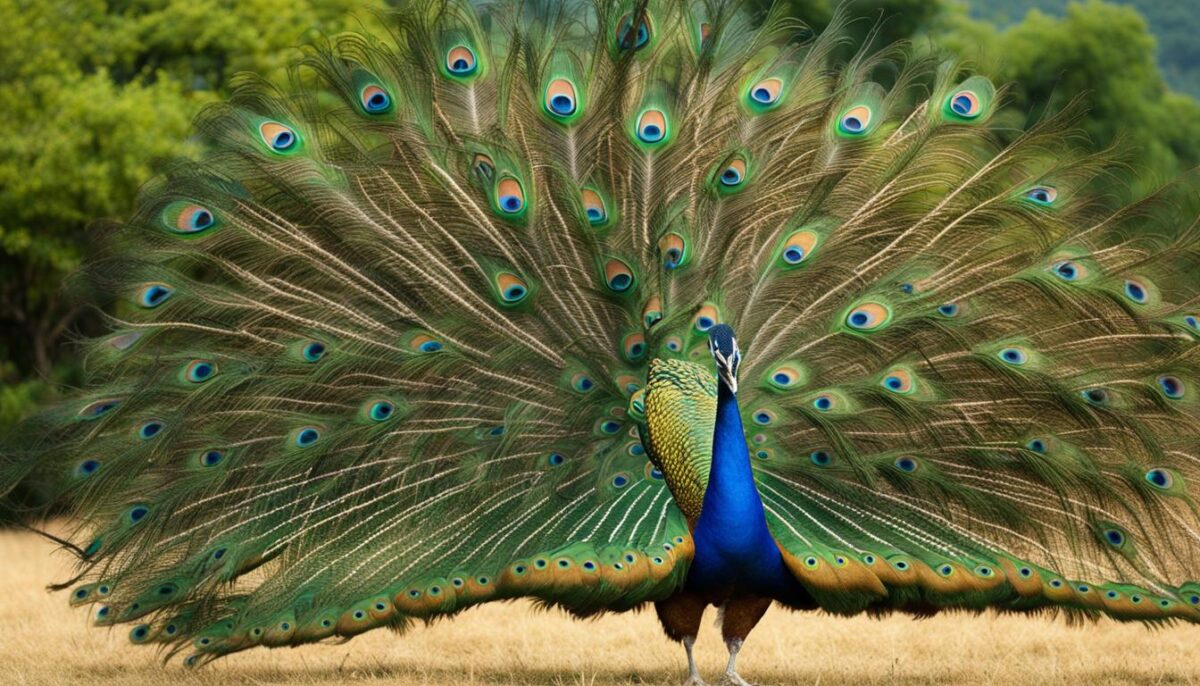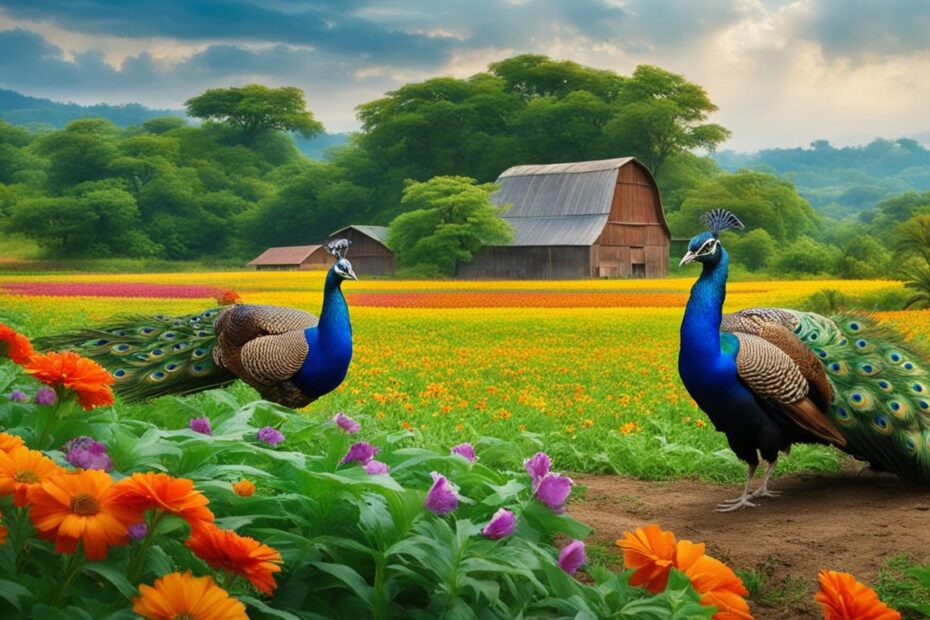Raising peacocks on a farm can offer various benefits. Peafowl are often raised for their fresh eggs and meat, as well as their colorful feathers. They can be a unique and aesthetically pleasing addition to a farm. Additionally, peafowl can serve as natural deterrents for pests due to their diet of insects, snakes, amphibians, and rodents.
Key Takeaways
- Peacocks on a farm provide fresh eggs, meat, and colorful feathers.
- Peafowl add a unique and aesthetically pleasing element to farm aesthetics.
- Peafowl act as natural pest deterrents due to their diet.
- Peacock farming offers multiple benefits for farmers and hobbyists.
- Peafowl can serve as a natural alarm system, alerting to potential threats.
The Beauty and Variety of Raising Peacocks
Raising peacocks on a hobby farm or in a backyard can add beauty and variety to the flock. Peafowl, including male peacocks and female peahens, are members of the pheasant family and can live up to 40 to 50 years. They come in various types, such as India Blue, Emerald, and White peacocks, with the albino peacock being extremely rare. Peafowl require a spacious coop and run, with a general rule of thumb being 80 square feet per bird and a pen height of at least 8 feet to accommodate their long tails.
One of the most striking aspects of raising peacocks is their vibrant plumage. Male peacocks display an array of colorful feathers, especially during their courtship displays. Their intricate patterns and iridescent shades can create a visually stunning spectacle on a farm. The vibrant plumage of peacocks has also made them popular ornamental birds, sought after for various crafts and décor.
India Blue peacocks are the most common variety found in the United States, known for their rich blue and green colors. Emerald peacocks, on the other hand, have a unique greenish hue that sets them apart. White peacocks, with their pure white feathers, are also highly prized for their ethereal beauty. These different varieties of peacocks add a touch of diversity and uniqueness to a hobby farm or backyard flock.
Table 1: Different Varieties of Peacocks
| Variety | Color |
|---|---|
| India Blue | Blue and Green |
| Emerald | Green |
| White | White |
With their striking appearance and the potential for various color combinations, peacocks can truly enhance the visual appeal of a hobby farm or backyard flock.
Quote: “The vibrant plumage of peacocks adds a touch of beauty and elegance to any farm. Their stunning feathers can be used for a variety of purposes, from crafting to home décor, making them a truly valuable addition to any flock.” – Farming Expert
Providing the Right Diet for Peafowl
Ensuring a proper diet is essential for maintaining the vibrant feathers of peafowl. These magnificent birds have feathers that are made up of 90 percent protein, making a high-protein diet crucial for their overall health and feather quality.
Peafowl require essential amino acids, which can be obtained through a complete feed specifically formulated for their dietary needs. The choice of feed should be based on the age and life stage of the birds, ensuring they receive the necessary nutrients for optimal growth and development.
Recommended options for peafowl include Purina® Game Bird Flight Conditioner and Purina® Flock Raiser®, which provide the right balance of protein, vitamins, and minerals. These feeds are designed to meet the specific dietary requirements of peafowl, promoting healthy feather growth and overall well-being.
Benefits of a High-Protein Diet
A high-protein diet not only supports peafowl in maintaining their vibrant feathers but also contributes to their overall health. Proteins are essential for muscle development, cell repair, and the production of enzymes and hormones.
By providing peafowl with a diet rich in protein, farm owners can ensure that their birds have the necessary building blocks for a healthy and active lifestyle. Additionally, a balanced diet will enhance the production of high-quality eggs and promote the overall vitality of the birds.
| Key Nutrients for Peafowl | Sources |
|---|---|
| Protein | Complete feed, insects, worms, and other protein-rich foods |
| Vitamins and Minerals | Complete feed, fresh fruits, vegetables, and supplements |
| Water | Clean, fresh water for hydration |
“A high-protein diet is crucial for peafowl, as it provides the necessary nutrients for vibrant feathers, muscle development, and overall well-being.” – John Farmer
Peafowl owners should ensure that their birds have access to clean, cool water at all times. Water is essential for hydration and plays a vital role in digestion and overall health.
By providing a well-balanced, high-protein diet, peafowl owners can support the natural beauty and health of these stunning birds, while also ensuring their long-term well-being on the farm.
Raising Quail and Other Game Birds
Raising game birds on a farm can offer additional benefits and variety. In addition to peafowl, quail, pheasants, and guineas are popular choices within the game bird category. One particularly favored game bird is the Coturnix quail, known for its compact size and social nature.
The Coturnix quail is commonly raised for both meat and egg production. They have excellent feed conversion rates, making them an efficient choice for farmers. These quail start laying eggs between 7 and 8 weeks of age, and they can produce 250 to 300 eggs per year. Their meat is also highly sought after, especially in certain countries in Asia.
When raising pheasants and guinea fowl, it is important to consider their specific dietary requirements. These birds should be fed a complete feed that is specially formulated for game birds, ensuring they receive the necessary nutrients for optimal growth and health.
The Benefits of Raising Quail and Other Game Birds
- Quail, pheasants, and guineas add variety to a farm and can be visually appealing.
- Coturnix quail are efficient in terms of both meat and egg production.
- Raising game birds can diversify farm income streams and meet market demand.
- They provide an opportunity for farmers to engage in niche markets and unique culinary experiences.
| Game Bird | Meat Production | Egg Production |
|---|---|---|
| Coturnix Quail | High | High |
| Pheasants | Medium | Low |
| Guinea Fowl | Medium | Low |
Raising game birds can offer farmers a unique opportunity to diversify their farm operations and meet market demands. Coturnix quail, in particular, are highly efficient in both meat and egg production, making them a popular choice. With their distinct flavors and versatile culinary uses, game birds can cater to niche markets and provide consumers with unique dining experiences.

Housing and Care for Peafowl on a Farm
Raising peafowl on a farm requires proper housing and care to ensure their well-being. Peafowl need a spacious enclosure with a roof to protect them from predators. It is essential to provide roosts at a height of 4.5 to 5 feet to prevent feather damage and frostbite. Additionally, peafowl should have access to shelter, especially in colder climates.
Table: Housing and Care Guidelines for Peafowl
| Aspect | Recommendations |
|---|---|
| Enclosure Size | Provide ample space for peafowl to roam, with a general rule of thumb being 80 square feet per bird. |
| Roost Height | Set roosts at a height of 4.5 to 5 feet to prevent feather damage and frostbite. |
| Predator Protection | Ensure the enclosure has a roof and is secure to protect peafowl from predators. |
| Cold Climate | Provide shelter to protect peafowl from harsh weather conditions, especially in colder climates. |
| Heat Tolerance | Peafowl are more tolerant to heat, but access to shade and cool water is still important to prevent heat stress. |
In addition to housing, it is crucial to provide clean, cool water for peafowl and to regularly worm them to prevent parasites. Monitoring their overall health and well-being is essential for their optimal care. By providing a suitable environment and attentive care, peafowl can thrive on a farm.
The Popularity and Trend of Raising Peafowl
Peafowl have become increasingly popular among farmers and hobbyists due to their ornamental value and unique features. Their vibrant plumage, especially the feathers of the male peacock, is highly sought after for various crafts, decor, and fashion accessories. The demand for peacocks and their feathers has led to a growing trend in raising these magnificent birds on farms.
One of the factors contributing to the popularity of peafowl is their striking appearance. The iridescent colors and intricate patterns of their feathers make them visually captivating, adding a touch of elegance to any setting. Peafowl feathers are often used in the creation of headdresses, costumes, and home decorations, making them a valuable commodity in the market.
“The feathers of peafowl are truly mesmerizing. Their beauty and uniqueness make them highly desirable for various artistic purposes. They add a touch of sophistication and glamour to any project or design.”
In addition to their ornamental value, the demand for peacocks themselves has also risen. People are increasingly interested in incorporating these majestic birds into their farms for their aesthetic appeal and as a unique attraction for visitors. While India Blue peafowl are the most common variety found in the United States, there is also a growing interest in breeding and raising other species, such as the Green peafowl, to diversify the offerings in the market.
Peafowl Popularity Statistics
| Year | Peafowl Sales (in thousands) | Feather Demand (in pounds) |
|---|---|---|
| 2015 | 50 | 100 |
| 2016 | 75 | 150 |
| 2017 | 100 | 200 |
| 2018 | 125 | 250 |
| 2019 | 150 | 300 |
As evident from the statistics above, the popularity of peafowl has been steadily increasing, with both sales of peafowl and feather demand showing significant growth over the years. This trend highlights the rising fascination and appreciation for the beauty and uniqueness of these birds, making them a valuable asset for farms and businesses in the industry.

Overall, the popularity and trend of raising peafowl can be attributed to their ornamental value, the demand for their feathers, and the desire for unique and captivating additions to farms. Whether it’s for their striking plumage or as an attraction for visitors, peafowl have become a sought-after choice for those seeking to add a touch of beauty and elegance to their farm.
Conclusion
Raising peacocks on a farm offers a myriad of benefits that make them a valuable addition to any agricultural setting. Not only do these magnificent birds enhance the aesthetics of the farm with their vibrant plumage, but they also serve important roles in pest control and act as unique ornamental birds.
One of the key advantages of peacock farming is their natural ability to control pests. Peafowl have a diverse diet that includes insects, snakes, amphibians, and rodents, making them effective in keeping the farm free from unwanted pests. This natural pest control reduces the need for chemical interventions, creating a more sustainable farming environment.
In addition to their pest control capabilities, peafowl bring a touch of beauty and elegance to the farm. Their colorful feathers are highly sought after for various crafts and decor, adding value to their ornamental appeal. Whether it’s the classic India Blue peafowl or the rarer green peafowl, these birds create a visually stunning landscape on the farm.
While peafowl require proper care and housing, the rewarding aspects of having them on a farm outweigh the challenges. By providing them with a spacious enclosure, proper roosts, shelter from predators, and access to clean water, farmers and hobbyists can ensure the well-being of their peafowl flock. With the numerous benefits they bring to the table, it’s no wonder that peacocks are becoming increasingly popular in the farming community.
FAQ
What are the benefits of raising peacocks on a farm?
Raising peacocks on a farm offers various benefits, including the production of fresh eggs and meat, their colorful feathers for crafts and decor, natural pest control through their diet, and their aesthetic appeal as unique ornamental birds.
What types of peafowl can be raised on a farm?
There are various types of peafowl that can be raised on a farm, including India Blue, Emerald, and White peacocks. The albino peacock is extremely rare. Each type has its own unique characteristics and plumage.
What should be included in the diet of peafowl?
Peafowl require a high-protein diet to maintain their vibrant feathers. Their diet should include essential amino acids, which can be provided through a complete feed. Recommended options for peafowl include Purina® Game Bird Flight Conditioner and Purina® Flock Raiser®.
What other game birds can be raised on a farm?
In addition to peafowl, other game birds suitable for raising on a farm include quail, pheasants, and guinea fowl. Coturnix quail are a popular choice as they have excellent feed conversion rates and can be raised for both meat and egg production.
Can peafowl serve as watchdogs on a farm?
Yes, peafowl can serve as excellent watch dogs on a farm. They have sharp senses and will alert to any movement or potential threats in their surroundings, making them a natural alarm system.
Are peafowl eggs and meat commonly consumed?
While peafowl eggs are edible and nutritious, they are generally not marketed regularly as food due to their high cost and limited availability. Peafowl meat is consumed in some Asian countries but is not in high demand in the United States.
What are the housing and care requirements for peafowl on a farm?
Peafowl require a spacious enclosure with a roof to provide protection from predators. Roosts should be provided at a height of 4.5 to 5 feet to prevent feather damage and frostbite. Peafowl should also have access to shelter, especially in cold climates, and clean, cool water. Regular worming is essential for their well-being.
What is the popularity of raising peafowl on a farm?
Raising peafowl has seen a resurgence in popularity in recent years, as more individuals seek unique additions to their farms. Peafowl, with their ornamental value and sought-after feathers, add beauty and variety to a farm.


